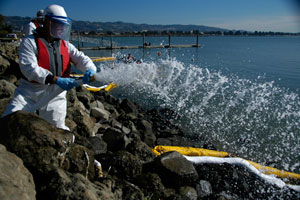Congressional investigators want to know why the Coast Guard consistently greenlighted BP’s requests to apply more dispersant chemicals to the Gulf spill than the company had been authorized to use; they are also raising queestions about whether the company used far more of these chemicals (whose health and environmental effects are largely unknown) than either BP or the Coast Guard have reported publicly.
It’s a question we asked several weeks ago, after Coast Guard logs indicated that BP had routinely sought and received approval to exceed the maximum daily amount of disperstants allowed under a May 26 joint directive from the Coast Guard and the Environmental Protection Agency.
Rep. Ed Markey (D-Mass.), chairman of the House energy and environment subcommittee, wants answers from the Coast Guard on why BP’s applications to exceed the dispersant limits “appeared to be rubber stamped,” even though the EPA stated that such exceptions should be granted only in “rare cases.” Further, subcommittee staff found discrepancies between dispersant figures BP reported to Congress and those it asked the Coast Guard approve, suggesting the firm used the chemicals in larger quantities than were authorized for use even under special circumstances.
In one example, the subcommittee staff found that Doug Suttles, BP’s chief operating officer, stated in a June 12 letter to the Coast Guard that the maximum daily application of dispersants on the surface in the days before June 16, 2010 was 3,360 gallons. But according to the dispersant totals BP provided to Markey’s committee, the company applied 14,305 gallons of dispersant on June 11 alone. The company reported using another 36,000 gallons on June 13 and 10,706 gallons June 14.
Not only does this raise questions about whether BP was playing straight with the government, but also about whether the Coast Guard was following through on its responsibility to monitor the company’s use of the chemicals. According to the official totals from BP and the Coast Guard, 1.8 million gallons of the chemicals have been applied. Now, it’s beginning to look like the real total may be much higher.
“BP carpet bombed the ocean with these chemicals, and the Coast Guard allowed them to do it,” said Markey in a statement. “After we discovered how toxic these chemicals really are, they had no business being spread across the Gulf in this manner.”













